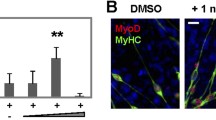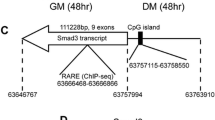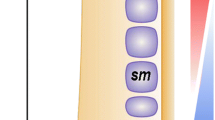Abstract
Retinoic acid (RA), an active metabolite of vitamin A, plays pivotal roles in a wide variety of biological processes, such as body patterning, organ development, and cell differentiation and proliferation. RA signaling is mediated by nuclear retinoic acid receptors, α, β, and γ (RARα, RARβ, and RARγ). RA is a well-known regulator of cartilage and skeleton formation and RARs are also essential for skeletal growth and hypertrophic chondrocyte-specific gene expression. These important roles of RA and RARs in chondrogenesis have been widely investigated using in vivo mouse models. However, few reports are available on the function of each subtype of RARs on in vitro chondrocyte differentiation. Here, we examined the effect of specific agonists of RARs on chondrogenic differentiation of ATDC5 and C3H10T1/2 cells. Subtype-specific RAR agonists as well as RA decreased the expressions of chondrogenic differentiation marker genes and inhibited chondrogenic differentiation, which was accompanied with morphological change to spindle-shaped cells. Among RAR agonists, RARα and RARγ agonists revealed a strong inhibitory effect on chondrogenic differentiation. RARα and RARγ agonists also hampered viability of ATDC5 cells. These observations suggested that RARα and RARγ are dominant receptors of RA signaling that negatively regulate chondrogenic differentiation.





Similar content being viewed by others
References
Chakkalakal SA, Uchibe K, Convente MR et al (2016) Palovarotene inhibits heterotopic ossification and maintains limb mobility and growth in mice with the human ACVR1(R206H) fibrodysplasia ossificans progressiva (FOP) mutation. J Bone Miner Res 31(9):1666–1675
Denker AE, Haas AR, Nicoll SB, Tuan RS (1999) Chondrogenic differentiation of murine C3H10T1/2 multipotential mesenchymal cells: I Stimulation by bone morphogenetic protein-2 in high-density micromass cultures. Differentiation 64(2):67–76
Dollé P, Ruberte E, Kastner P et al (1989) Differential expression of genes encoding alpha, beta and gamma retinoic acid receptors and CRABP in the developing limbs of the mouse. Nature 342(6250):702–705
Enomoto M, Pan H, Suzuki F, Takigawa M (1990) Physiological role of vitamin A in growth cartilage cells: low concentrations of retinoic acid strongly promote the proliferation of rabbit costal growth cartilage cells in culture. J Biochem 107(5):743–748
Hein R, Krieg T, Mueller PK, Braun-Falco O (1984) Effect of retinoids on collagen production by chondrocytes in culture. Biochem Pharmacol 33(20):3263–3267
Horton W, Hassell JR (1986) Independence of cell shape and loss of cartilage matrix production during retinoic acid treatment of cultured chondrocytes. Dev Biol 115(2):392–397
Iwamoto M, Golden EB, Adams SL, Noji S, Pacifici M (1993) Responsiveness to retinoic acid changes during chondrocyte maturation. Exp Cell Res 205(2):213–224
Li N, Xu Y, Zhang H et al (2014) Excessive retinoic acid impaired proliferation and differentiation of human fetal palatal chondrocytes (hFPCs). Birth Defects Res B Dev Reprod Toxicol 101(3):276–282
Minegishi Y, Sakai Y, Yahara Y et al (2014) Cyp26b1 within the growth plate regulates bone growth in juvenile mice. Biochem Biophys Res Commun 454(1):12–18
Mollard R, Viville S, Ward SJ, Décimo D, Chambon P, Dollé P (2000) Tissue-specific expression of retinoic acid receptor isoform transcripts in the mouse embryo. Mech Dev 94(1–2):223–232
Pacifici M, Cossu G, Molinaro M, Tato F (1980) Vitamin A inhibits chondrogenesis but not myogenesis. Exp Cell Res 129(2):469–474
Ruberte E, Dolle P, Krust A, Zelent A, Morriss-Kay G, Chambon P (1990) Specific spatial and temporal distribution of retinoic acid receptor gamma transcripts during mouse embryogenesis. Development 108(2):213–222
Shimono K, Morrison TN, Tung WE, Chandraratna RA, Williams JA, Iwamoto M, Pacifici M (2010) Inhibition of ectopic bone formation by a selective retinoic acid receptor α-agonist: a new therapy for heterotopic ossification? J Orthop Res 17(4):454–460
Shimono K, Tung WE, Macolino C et al (2011) Potent inhibition of heterotopic ossification by nuclear retinoic acid receptor-gamma agonists. Nat Med 17(4):454–460
Takigawa M, Ishida H, Takano T, Suzuki F (1980) Polyamine and differentiation: induction of ornithine decarboxylase by parathyroid hormone is a good marker of differentiated chondrocytes. Proc Natl Acad Sci USA 77(3):1481–1485
Takishita Y, Hiraiwa K, Nagayama M (1990) Effect of retinoic acid on proliferation and differentiation of cultured chondrocytes in terminal differentiation. J Biochem 107(4):592–596
Uchibe K, Son J, Larmour C, Pacifici M, Enomoto-Iwamoto M, Iwamoto M (2017) Genetic and pharmacological inhibition of retinoic acid receptor gamma function promotes endochondral bone formation. J Orthop Res 35(5):1096–1105
van Neerven S, Mey J (2007) RAR/RXR and PPAR/RXR Signaling in Spinal Cord Injury. PPAR Res 2007:29275
Weston AD, Rosen V, Chandraratna RA, Underhill TM (2000) Regulation of skeletal progenitor differentiation by the BMP and retinoid signaling pathways. J Cell Biol 148(4):679–690
Weston AD, Chandraratna RA, Torchia J, Underhill TM (2002) Requirement for RAR-mediated gene repression in skeletal progenitor differentiation. J Cell Biol 158(1):39–51
Williams JA, Kondo N, Okabe T et al (2009) Retinoic acid receptors are required for skeletal growth, matrix homeostasis and growth plate function in postnatal mouse. Dev Biol 328(2):315–327
Williams JA, Kane M, Okabe T et al (2010) Endogenous retinoids in mammalian growth plate cartilage: analysis and roles in matrix homeostasis and turnover. J Biol Chem 285(47):36674–36681
Acknowledgements
This study was supported in part by JSPS KAKENHI [Grant Numbers JP16K21186 (to K.U.) and JP19H03859 (to H.K.)].
Author information
Authors and Affiliations
Contributions
KU designed the experiments. YS, KU, KY, YW, JG, HY, MI, HK, and HO conducted the experiments, evaluated the results, and prepared the manuscript. All authors have read and approved the final submitted manuscript.
Corresponding author
Ethics declarations
Conflict of interest
The authors declare that they have no conflict of interest.
Additional information
Publisher's Note
Springer Nature remains neutral with regard to jurisdictional claims in published maps and institutional affiliations.
Rights and permissions
About this article
Cite this article
Sumitani, Y., Uchibe, K., Yoshida, K. et al. Inhibitory effect of retinoic acid receptor agonists on in vitro chondrogenic differentiation. Anat Sci Int 95, 202–208 (2020). https://doi.org/10.1007/s12565-019-00512-3
Received:
Accepted:
Published:
Issue Date:
DOI: https://doi.org/10.1007/s12565-019-00512-3




